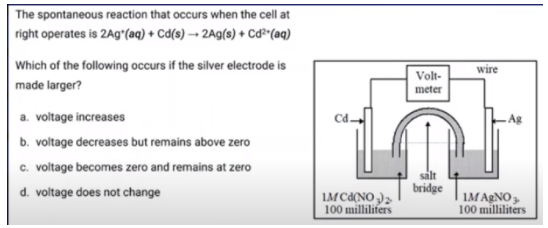9.9 Cell Potential Under Nonstandard Conditions
Introduction to Electrochemical Cells Beyond Standard Conditions
Electrochemical cells generate electrical energy through chemical reactions. However, these reactions don’t always occur under standard conditions (298.15 K, 1 atm, and 1 M concentrations). Understanding how cell potential varies under nonstandard conditions is crucial for predicting and analyzing cell performance in real-world scenarios. In this section, we’ll explore how concentration, cell potential, and equilibrium interplay using the Nernst Equation.
Comparing Ecell and E°cell
Recall from earlier lessons that standard cell potential (E°cell) is calculated when all components are under standard conditions. However, real electrochemical cells often operate under nonstandard conditions. The potential under these conditions, denoted as Ecell, can differ from E°cell based on the concentrations of reactants and products.
Key Insight: A galvanic cell that is actively running is not at equilibrium. As the cell moves toward equilibrium, its potential decreases until it eventually reaches zero—similar to a dead battery.
The Relationship Between Ecell and Equilibrium
As a cell approaches equilibrium:
- Ecell approaches zero.
- The reaction quotient, Q, plays a critical role. When Q = K (equilibrium constant), Ecell = 0.
The Nernst Equation
The Nernst Equation quantifies the relationship between Ecell and E°cell under nonstandard conditions:
Where:
- Ecell = cell potential at nonstandard conditions
- E°cell = standard cell potential
- R = universal gas constant (8.314 J/mol·K)
- T = temperature (Kelvin)
- n = moles of electrons transferred
- F = Faraday’s constant (96485 C/mol e-)
- Q = reaction quotient
Key Takeaway: The Nernst Equation allows us to predict how the cell potential will change based on the concentrations of the reactants and products.
Concentration and Its Effect on Cell Potential
Concentration plays a pivotal role in determining Ecell:
- When Q > 1: There are more products than reactants, leading to Ecell < E°cell.
- When Q < 1: There are more reactants than products, resulting in Ecell > E°cell.
Example Calculation: Consider the reaction:
We analyze how different conditions affect Ecell compared to E°cell:
- [Al³⁺] = 1.5M and [Mn²⁺] = 1.0M
- [Al³⁺] = 1.0M and [Mn²⁺] = 1.5M
- [Al³⁺] = 1.5M and [Mn²⁺] = 1.5M
Tip: A higher product concentration (Q > 1) leads to a decrease in cell potential, while a higher reactant concentration (Q < 1) increases it.
Using the Nernst Equation for Predictions
The Nernst Equation is a powerful tool for predicting how changes in concentration, temperature, and reaction conditions affect cell potential. While you won’t be required to perform complex calculations on the AP Chemistry Exam, understanding the qualitative relationships between E°cell, Ecell, and Q is essential.
Example Application
Given:
- E°cell = 1.02 V
- n = 1 mole of electrons
- T = 298 K
Calculate the effect of different concentrations on Ecell using the Nernst Equation:
Connection to Gibbs Free Energy
Remember that cell potential directly relates to the spontaneity of a reaction through Gibbs Free Energy (ΔG):
This relationship underscores how changes in Ecell can affect the overall energy and feasibility of reactions.
Summary of Key Concepts
- Cell potential changes under nonstandard conditions based on concentration and reaction quotient Q.
- Ecell > E°cell when Q < 1 (more reactants).
- Ecell < E°cell when Q > 1 (more products).
- The Nernst Equation links Ecell to concentration, temperature, and equilibrium constants.








